Star Power: Blazing the Path to Fusion Ignition
February 23, 2023
Part 1 of “The Age of Ignition,” a NIF & Photon Science News Special Report describing the elements of Lawrence Livermore National Laboratory’s fusion breakthrough at the National Ignition Facility
It was the middle of the night on Dec. 5, 2022, and anticipation was building among the handful of researchers and technicians in the National Ignition Facility (NIF) Control Room. A set of pre-shot simulations had predicted a slightly better than 50-50 chance that the impending nuclear fusion experiment would reach or exceed “break-even“—producing as much or more energy than it used to drive the fusion reaction.

The shot had been delayed for the completion of optics installations and other tasks from the weekend’s facility maintenance period. Finally at 1:03 a.m., the computer-controlled countdown reached zero, shot director Joseph Griffo pronounced, “Shot!,” and NIF’s 192 powerful lasers fired 2.05 megajoules (million joules) of ultraviolet energy into the ends of a pencil eraser-sized cylinder holding a tiny capsule of hydrogen fuel.
Radiation alarms sounded in unoccupied areas of the facility as the heavily-shielded Target Chamber was flooded with 1.12×1018 (1.12 quintillion) high-energy neutrons—the equivalent of 3.15 megajoules of fusion energy—produced by an explosive, self-sustaining thermonuclear reaction. Monitors began to display the unprecedented neutron yield captured by an array of diagnostic instruments, and the broad smiles and hearty high-fives around the Control Room told the story:
After 12 years of sustained and often frustrating effort and hundreds of experiments, Lawrence Livermore National Laboratory (LLNL) had achieved ignition—meeting a milestone that tantalized the inertial confinement fusion (ICF) community for more than 60 years and launching the age of controlled fusion ignition in the laboratory.
 Researchers and technicians in the NIF Control Room react to U.S. Secretary of Energy Jennifer Granholm’s Dec. 13 announcement that LLNL had achieved fusion ignition for the first time. Granholm likened ignition to the Wright Brothers’ first flight and called it “one of the most impressive scientific feats of the 21st century.” Credit: Jason Laurea
Researchers and technicians in the NIF Control Room react to U.S. Secretary of Energy Jennifer Granholm’s Dec. 13 announcement that LLNL had achieved fusion ignition for the first time. Granholm likened ignition to the Wright Brothers’ first flight and called it “one of the most impressive scientific feats of the 21st century.” Credit: Jason Laurea “This was only the second NIF shot to deliver more than two megajoules of ultraviolet energy to an ICF target,” said NIF Operations Manager Bruno Van Wonterghem. “This shot is just the beginning of a whole new level of ICF operations.”
LLNL physicist Alex Zylstra, the shot’s principal experimentalist, was waiting at home for news of the result. “As the data started to come in,” he said, “we saw the first indications that we had produced more fusion energy than the laser input. One of the first things I did was call one of the diagnostic experts to double-check the data, and we kind of went from there.”
That expert was Dave Schlossberg, science lead for the NIF Nuclear Diagnostics group, who had asked Zylstra to call him if anything interesting happened.
“My phone rang at about 1:30 a.m. and it was Alex, quite excited,” Schlossberg said. “The first neutron data was rolling in, and it indicated higher performance than we’d ever seen before.
“In the pitch black of my living room from 2 to 4 a.m. Monday morning,” he said, “I quickly confirmed the validity of these results and continued communicating with Alex. More data rolled in from other diagnostics, and we excitedly realized this was a momentous event.”
“Ignition is a first step, a truly monumental one that sets the stage for a transformational decade in high energy density science and fusion research, and I cannot wait to see where it takes us.”
—LLNL Director Kim Budil
The preliminary data were quickly shared with Zylstra’s colleagues. Annie Kritcher, the experiment’s lead designer and team lead for integrated modeling, had gone to bed and was having “vivid dreams of all possible outcomes from the shot. This always happens before a shot,” she said, “from complete success to utter failure.
“Thankfully, Alex had sent me a message, so by the time I woke up, I saw that it wasn’t a failure. You see one diagnostic and you think, ‘Well, maybe that’s not real.’ And then you start to see more and more diagnostics rolling in pointing to the same thing, and it’s just a great feeling.”
Later that morning, members of the NIF management team could barely contain their excitement as they waited for the diagnostic data to be processed. They were overjoyed when the initial analysis confirmed that NIF had lived up to the promise of its middle name.
Over the next few days, the data were carefully analyzed by NIF’s nuclear diagnostics group, x-ray group, and other target diagnostic experts, and peer-reviewed by outside consultants. The validated results were announced to the rest of the NIF & Photon Science (NIF&PS) team on Dec. 9, and to the world through a U.S. Department of Energy (DOE) news conference on Dec. 13.
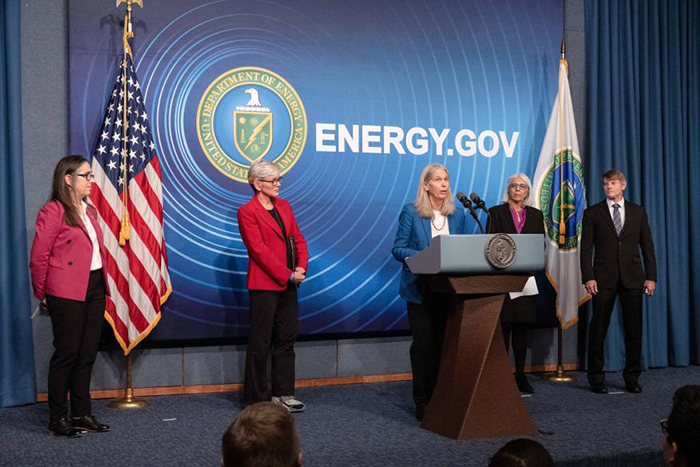 Jill Hruby, DOE under secretary for Nuclear Security and administrator of the National Nuclear Security Administration (NNSA), discusses LLNL’s fusion breakthrough at the DOE news conference in Washington, D.C. Hruby said LLNL researchers have “opened a new chapter in NNSA’s science-based Stockpile Stewardship Program.” Hruby is flanked by, from left, LLNL Director Kim Budil, Energy Secretary Jennifer Granholm, White House Office of Science and Technology Policy Director Arati Prabhakar, and NNSA Deputy Administrator for Defense Programs Marvin “Marv” Adams. Credit: DOE View the Video
Jill Hruby, DOE under secretary for Nuclear Security and administrator of the National Nuclear Security Administration (NNSA), discusses LLNL’s fusion breakthrough at the DOE news conference in Washington, D.C. Hruby said LLNL researchers have “opened a new chapter in NNSA’s science-based Stockpile Stewardship Program.” Hruby is flanked by, from left, LLNL Director Kim Budil, Energy Secretary Jennifer Granholm, White House Office of Science and Technology Policy Director Arati Prabhakar, and NNSA Deputy Administrator for Defense Programs Marvin “Marv” Adams. Credit: DOE View the Video The historic achievement, which more than doubled NIF’s previous energy record, marked a significant advance in LLNL’s support for the National Nuclear Security Administration (NNSA)’s science-based Stockpile Stewardship Program to maintain the reliability and security of the nation’s nuclear deterrent without underground testing. It also furthered LLNL’s research in high energy density science and demonstrated the fundamental science basis for inertial fusion energy (IFE), emboldening further research into the development of IFE as a potential source of clean, safe, and limitless energy.

What’s more, the Dec. 5 experiment was only the first of several shots that achieved ignition during the following months. On July 30, 2023, the NIF laser again delivered 2.05 MJ of energy to the target, resulting in 3.88 MJ of fusion energy output, the highest yield achieved to date. On Oct. 8, 2023, NIF achieved fusion ignition for the third time with 1.9 MJ of laser energy resulting in 2.4 MJ of fusion energy yield.
And on Oct. 30, 2023, NIF set a new record for laser energy, firing 2.2 MJ of energy for the first time on an ignition target. This experiment resulted in 3.4 MJ of fusion energy yield, the second-highest neutron yield ever achieved on NIF.
These results demonstrate that NIF can repeatedly conduct fusion experiments at multi-megajoule levels.
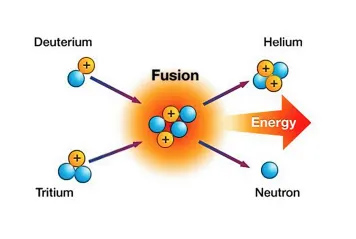 In a fusion reaction, the process that powers the Sun and the stars, the nuclei of the two isotopes of hydrogen, deuterium (containing one neutron and one proton) and tritium (two neutrons and one proton), are forced together by extremes of temperature and pressure and fuse to form a helium nucleus, also called an alpha particle. In the process some of the mass of the hydrogen is released as energy.
In a fusion reaction, the process that powers the Sun and the stars, the nuclei of the two isotopes of hydrogen, deuterium (containing one neutron and one proton) and tritium (two neutrons and one proton), are forced together by extremes of temperature and pressure and fuse to form a helium nucleus, also called an alpha particle. In the process some of the mass of the hydrogen is released as energy. International Teamwork
Reaching ignition was made possible by contributions from the Laboratory’s NIF&PS, Strategic Deterrence, Physical and Life Sciences, and Computing teams; scientists, engineers, technicians, and administrative and support personnel from throughout the Laboratory; and extensive collaborations with researchers in the world’s fusion, plasma physics, and high energy density science communities in other national laboratories, universities, and industry.
LLNL Director Kim Budil also credited “the many supporters and stakeholders in the National Nuclear Security Administration, the Department of Energy, and in Congress, who’ve ensured we could reach this moment, even when the going was tough.
“The pursuit of fusion ignition in the laboratory is one of the most significant scientific challenges ever tackled by humanity,” Budil said. “Achieving it is a triumph of science, engineering, and most of all, people.”
Among the key factors enabling the breakthrough:
- Creative experimental designs informed by steady increases in the scientific understanding of the complex physics of inertial confinement fusion.
- Record levels of energy generated by NIF’s lasers.
- Increasingly damage-resistant optics that enable the laser system to operate at energies and powers well beyond its design specifications.
- Terabytes of data from NIF’s suite of more than 100 state-of-the-art nuclear, x-ray, and optical diagnostics.
- Enhanced experiment-based modeling and simulation that helped shape the new experimental designs.
- Advancements in the metrology and fabrication of custom-made targets.
Ignition on NIF, the world’s largest and highest-energy laser system, means the nuclear fusion reactions sparked by the lasers produce as much or more energy than the laser energy delivered to the target—the definition of ignition used by the National Academy of Science in a 1997 review of NIF (see “Achieving Fusion Ignition”).
In NIF ICF experiments, a target capsule containing two forms of hydrogen, deuterium (D) and tritium (T), is suspended inside the cylindrical x-ray “oven,” called a hohlraum. On the capsule’s inside surface is a thin layer of cryogenically cooled DT and a volume of DT gas. When the hohlraum is heated by NIF’s laser beams to temperatures of more than three million degrees Celsius, the resulting x rays heat and blow off, or ablate, the outer surface of the capsule, called the ablator. This causes a rocket-like implosion that compresses and heats the DT fuel.
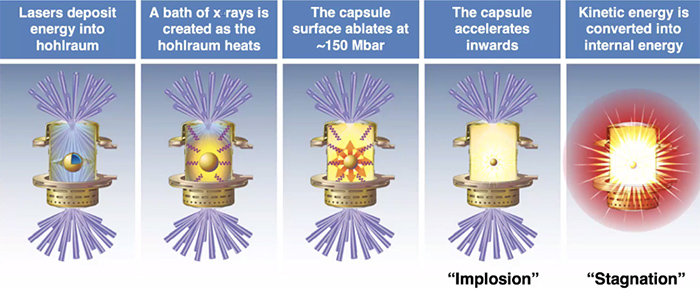 Illustration of laser-driven inertial confinement fusion. In ignition experiments, the implosion crushes the capsule to smaller than the width of a human hair, impelling the fuel to temperatures and densities exceeding those found in the sun. Achieving the conditions for ignition demands precise control of design, laser, and target parameters.
Illustration of laser-driven inertial confinement fusion. In ignition experiments, the implosion crushes the capsule to smaller than the width of a human hair, impelling the fuel to temperatures and densities exceeding those found in the sun. Achieving the conditions for ignition demands precise control of design, laser, and target parameters. In this “indirect-drive” process, the shape of the imploding fuel must remain as spherical as possible to maximize compression and form a stable central “hot spot.” Ignition occurs when the energy from a self-sustaining fusion reaction overcomes the cooling effects of x-ray losses, electron conduction, and implosion expansion.
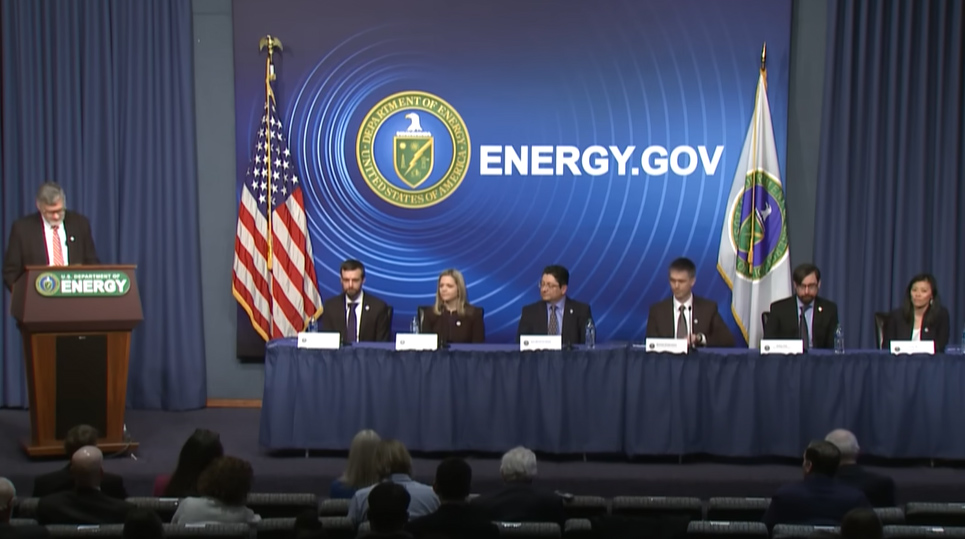 A technical panel of LLNL scientists convened following the Dec. 13 DOE news conference to discuss details of the achievement and what ignition might mean for the future of fusion energy. Mark Herrmann (left), LLNL program director for Weapon Physics and Design, moderated. The panelists were (from left) Alex Zylstra, principal experimentalist; Annie Kritcher, lead designer; Jean-Michel Di Nicola, NIF laser systems chief engineer; Michael Stadermann, target fabrication program manager; Arthur Pak, team lead for stagnation science; and Tammy Ma, lead for the Laboratory’s Inertial Fusion Energy Institutional Initiative. Credit: DOE View the Video
A technical panel of LLNL scientists convened following the Dec. 13 DOE news conference to discuss details of the achievement and what ignition might mean for the future of fusion energy. Mark Herrmann (left), LLNL program director for Weapon Physics and Design, moderated. The panelists were (from left) Alex Zylstra, principal experimentalist; Annie Kritcher, lead designer; Jean-Michel Di Nicola, NIF laser systems chief engineer; Michael Stadermann, target fabrication program manager; Arthur Pak, team lead for stagnation science; and Tammy Ma, lead for the Laboratory’s Inertial Fusion Energy Institutional Initiative. Credit: DOE View the Video Chasing History
Reaching ignition crowned six decades of research and development of the world’s highest-energy lasers at LLNL, all working toward the goal of creating in the laboratory the temperatures and pressures found only in the center of stars and giant planets and in exploding nuclear weapons.
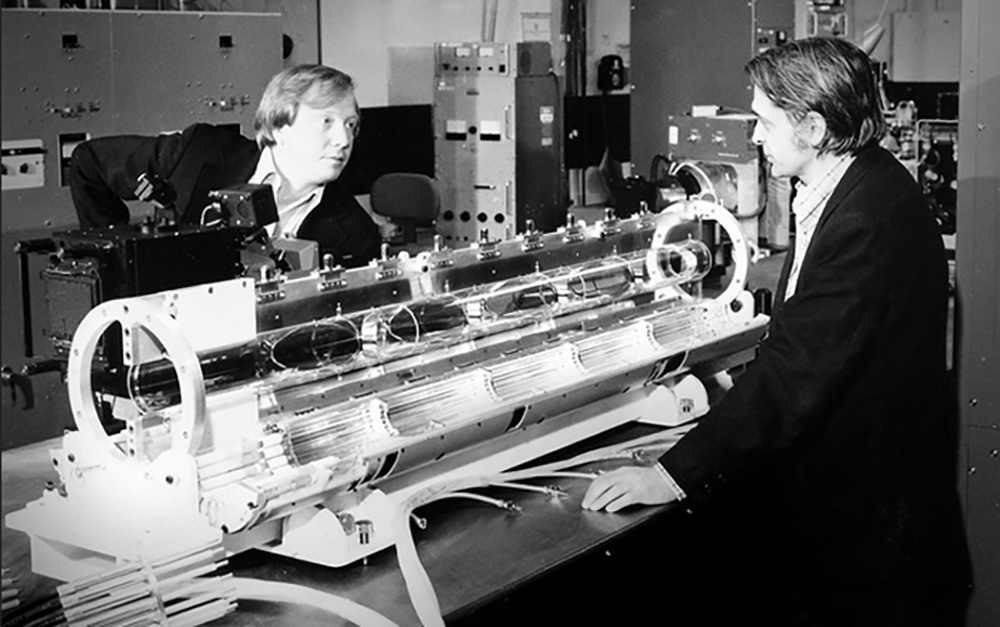 Physicists John Emmett (left) and John Nuckolls, early LLNL pioneers in laser and ICF technology.
Physicists John Emmett (left) and John Nuckolls, early LLNL pioneers in laser and ICF technology. And it fulfilled the vision of the Laboratory’s fusion pioneers, such as former LLNL Director John Nuckolls; John Emmett, the first leader of the Laboratory’s consolidated laser programs; and former NIF Chief Scientist John Lindl, who literally wrote the book on the physics of indirect-drive ICF in 1998.
Nuckolls recalled that when he first conceived of using lasers to create the power of the stars in a laboratory, “I said, ‘We have two problems: How am I going to get a million-joule laser?’ because that’s what I calculated we would need. The next problem was, ‘I don’t think I’m going to live long enough.’
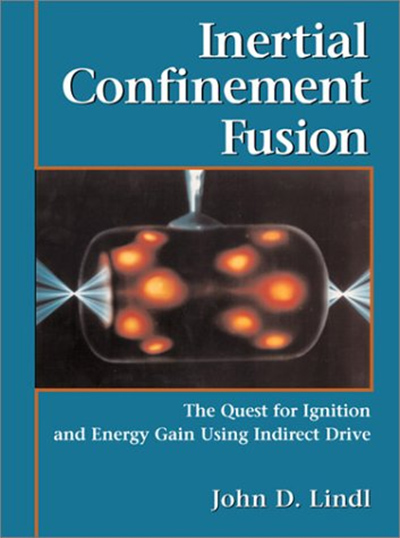
“I lucked out,” he said, “and here I am, and here’s this wonderful program. Incredible, it’s beyond belief.”
Lindl, who joined the ICF program in 1972 and became the leader of the Laser Target Design Group in 1978, presented the original proposal for NIF to the National Academy of Science in 1989. He said the academy gave the project only a 50-50 chance of achieving ignition.
“I would say that, by far, the majority of the scientific community was very skeptical, if not downright dismissive, of the likelihood that we would succeed,” Lindl said. “But there have been enough people who believed we could do it and sustained the support for what we’ve been doing that got us to this point.
“Fortunately, we were on the positive side of the 50-50 proposition.”
Solving Problems
To get to ignition, LLNL researchers confronted and overcame a wide variety of issues: implosion asymmetries and hydrodynamic instabilities; fuel contamination by material from the target capsule; radiative losses; laser backscatter; and perturbations caused by the ultra-thin “tents” holding the capsule inside the hohlraum and the tiny tubes used to fill the capsule with fuel.
The researchers met in an auditorium almost every week to review the results and implications of the previous week’s experiments—doing their best to tease out the subtle nuances of one of history’s toughest scientific quests.
“We knew we were moving in the direction where things should start working better.”
—ICF Chief Scientist Omar Hurricane
They adjusted the energy and timing of the laser pulses, experimented with new target designs and materials, found ways to couple more laser energy to the target to boost the hot-spot pressure and temperature, and made NIF’s optics more resistant to laser damage.
Nino Landen, the ICF Experiments Program group leader, noted that the road to ignition also represents “the culmination of developing and refining state-of-the-art diagnostics and active probe techniques over several decades by hundreds of scientists, engineers, and technicians” at NIF’s predecessor, the Nova Laser at LLNL, the Omega Laser Facility at the University of Rochester, and NIF.
“These allowed us to measure and understand hohlraum and capsule conditions and sensitivities, and ultimately adjust the input laser and target parameters for optimizing implosion performance,” Landen said. “The experimental developments led notably over decades by Mike Campbell (former Laser Programs associate director) and Joe Kilkenny (former ICF Program leader and current chief systems engineer for Measurement Systems) to advance ICF have also proved useful for a broader set of high energy density science experiments.”
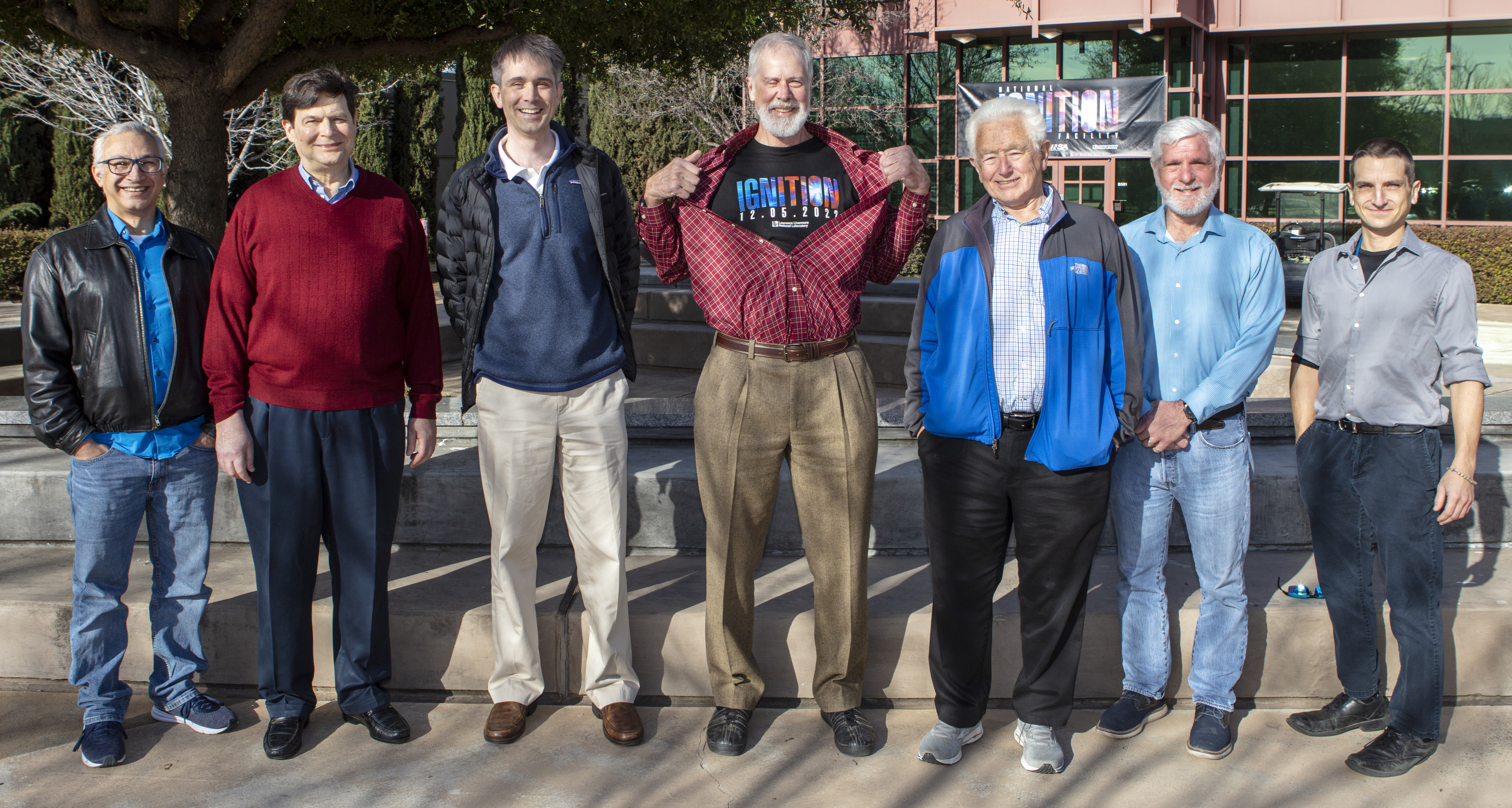 Among the many researchers who contributed to LLNL’s groundbreaking ignition experiment were (from left) Omar Hurricane, Nino Landen, Michael Stadermann, John Lindl, Joe Kilkenny, Doug Larson, and Dave Schlossberg. Credit: Jason Laurea
Among the many researchers who contributed to LLNL’s groundbreaking ignition experiment were (from left) Omar Hurricane, Nino Landen, Michael Stadermann, John Lindl, Joe Kilkenny, Doug Larson, and Dave Schlossberg. Credit: Jason Laurea The researchers knew they were on the threshold of ignition when an Aug. 8, 2021, experiment produced 1.35 megajoules (MJ) of energy, about 70 percent of the 1.92 MJ of laser energy absorbed by the target. That experiment incorporated several design changes that boosted the energy reaching the fuel.
The resulting fusion reactions propelled almost 500 quadrillion energetic alpha particles (helium nuclei) into the cold fuel surrounding the hot spot, igniting a self-sustaining “burn wave” of additional reactions that consumed about 2 percent of the fuel.
The Aug. 8 result, as well as NIF shots in 2020 and 2021 that produced a burning plasma for the first time, “showed an existence proof that ignition was possible,” said ICF Chief Scientist Omar Hurricane. “We knew we were moving in the direction where things should start working better.
“The last 10 years have been tough; we were counted out so many times,” he added. “But it has also been steady progress to get to this point; 10 years is a relatively short time for such a hard scientific challenge.”
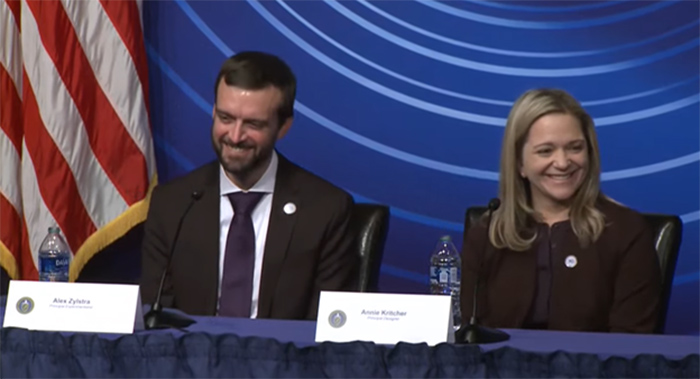 Alex Zylstra and Annie Kritcher enjoy a light moment during the technical panel discussion.
Alex Zylstra and Annie Kritcher enjoy a light moment during the technical panel discussion. Crossing the Threshold
The Dec. 5 ignition shot was the second in a modified experimental campaign, called “Hybrid-E High Energy” (HyeHE), that built on earlier Hybrid designs but included design improvements for higher fusion energy output: about 8 percent more laser energy (2.05 MJ), a longer pulse, and a thicker (by 6 microns) target capsule (a micron is one-millionth of a meter).
“In the future, the NIF laser could produce even higher energies and power and promise larger target gains.”
—NIF Chief Laser Engineer Jean-Michel Di Nicola
The higher-energy shot was enabled in part by implementing several technologies to protect NIF’s optics from damage. They included the installation of 80 additional high-quality fused silica debris shields, for a total of 128 of NIF’s 192 beamlines, to protect the final optics from debris generated by less-durable disposable shields (see NIF’s Optics Meet the Demands of Increased Laser Energy’).
The HyeHE campaign’s goal was to overcome variations that had stymied several earlier efforts to replicate the 2021 results, such as implosion asymmetries and fuel contamination by capsule material, that were linked to microscopic defects in the capsules.
“The whole point behind this new design change—higher energy and a thicker ablator—was to have more margin against needing to have a very pristine capsule,” Kritcher explained. “The thicker capsule also lets us burn up more of the DT fusion fuel.”
Building on Understanding
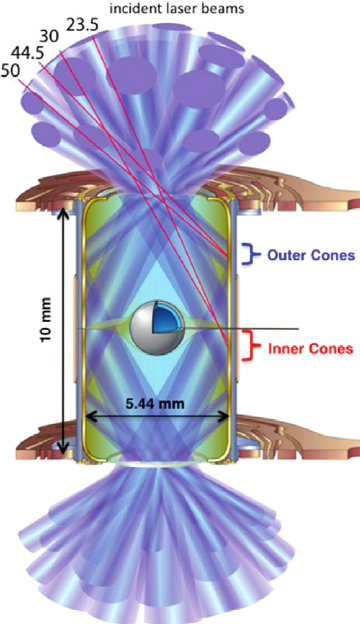 Illustration of a NIF target showing the inner and outer cone beams impacting the interior wall of the hohlraum.
Illustration of a NIF target showing the inner and outer cone beams impacting the interior wall of the hohlraum. The first shot in the new campaign, on Sept. 19, produced about 1.2 MJ of energy, falling just short of the 2021 result primarily because the implosion was driven oblate, leading to a pancake-shaped hot spot that wasted some of the additional laser energy.
To improve symmetry for the December shot, the researchers adjusted the balance of energy among the laser beams, both at the start and in the main part of the pulse. At the peak of the pulse, this was achieved by wavelength tuning—slightly changing the wavelength of one or more sets of beams to control the exchange of energy as the beams crossed in the laser entrance holes.
 Primary neutron imaging by the NIF neutron imaging spectrometer developed by Los Alamos National Laboratory shows the implosion shape of the Sept. 19 experiment (left) and the Dec. 5 shot that achieved ignition. The September implosion was slightly oblate, or pancake-shaped, while the December shot was more symmetric.
Primary neutron imaging by the NIF neutron imaging spectrometer developed by Los Alamos National Laboratory shows the implosion shape of the Sept. 19 experiment (left) and the Dec. 5 shot that achieved ignition. The September implosion was slightly oblate, or pancake-shaped, while the December shot was more symmetric. This rebalancing of the laser energy helped equalize the x-ray drive so energy was evenly distributed throughout the hohlraum, producing a more symmetric implosion that burned about 4 percent of the fuel and resulted in ignition (see “Designing for Ignition: Precise Changes Yield Historic Results”).
Significantly, the ignition experiment used a target capsule with many more surface and subsurface defects and high-Z (high atomic number) “inclusions” than the 2021 experiment that moved NIF to the threshold of ignition.
The new design was shared with LLNL’s cognitive simulation team, and they concluded that “we had a greater than 50 percent probability of achieving the National Academy of Science’s definition of ignition,” said LLNL design physicist Kelli Humbird. “This was the first time we’ve attempted this kind of prediction, and our current data-driven model indicated there was a substantially higher chance of achieving ignition with this design when compared to the August 8 design.”
Target Fabrication Program Manager Michael Stadermann said the fact that the capsule was flawed was “very encouraging” for the team. “This gives us confidence that we can make shells of equal quality or even better quality in the future—that we’ll be able to reproduce this experiment or even improve on it,” he said.
Why Pursue Ignition?
Accessing the energies of fusion ignition will enable stockpile stewardship experiments at a new level of high energy density conditions. Ignition will also help weapons scientists test and refine the computer models they use to better understand and assess the performance of the stockpile’s aging nuclear weapons.
“Fusion ignition is a key process in our thermonuclear weapons,” said Mark Herrmann, LLNL’s program director for weapons physics and design. “The very extreme environments created when the fusion plasma ignites enables testing that ensures that we can maintain and modernize our nuclear deterrent.”
Added Budil: “Our leadership in science and technology helps to build strong relationships with our allies and partners and to demonstrate our capabilities to our adversaries.”
Ignition experiments also will help assess the survivability of nuclear weapon components and other weapon-relevant materials important to national security. The cryogenic-compatible x-ray, neutron, and blast snout (XNBS) used in the first high energy density neutron survivability test on Dec. 5. The Dec. 5 shot was the first experiment “where we put the ignition platform to work for stewardship,” said now-retired NIF Director Doug Larson. The experiment fired a blast of x-ray and neutron radiation on depleted uranium samples and test objects, a step toward eventually conducting enriched uranium and plutonium survivability experiments.
The cryogenic-compatible x-ray, neutron, and blast snout (XNBS) used in the first high energy density neutron survivability test on Dec. 5. The Dec. 5 shot was the first experiment “where we put the ignition platform to work for stewardship,” said now-retired NIF Director Doug Larson. The experiment fired a blast of x-ray and neutron radiation on depleted uranium samples and test objects, a step toward eventually conducting enriched uranium and plutonium survivability experiments.
“Nobody else can do that,” Larson said. “Nobody else has an intense pulsed source of 14 MeV (14 million electron-volt) neutrons to assess stockpile survivability questions. Right now it’s (about) survivability, but as we attain even higher yield, it’ll broaden to other (stewardship) applications.”
The data and insights from ignition experiments also will help evolve inertial fusion energy, or IFE, as a viable technology for future power plants.
Achieving ignition “demonstrates the basic scientific feasibility” of IFE, said Tammy Ma, lead for LLNL’s Institutional Initiative in Inertial Fusion Energy.
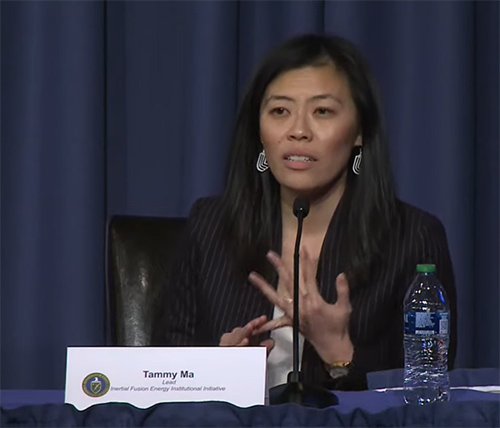 Tammy Ma
Tammy Ma “Developing an economically attractive approach to fusion energy is a grand scientific and engineering challenge,” she said. “Without a doubt, it will be a monumental undertaking. However, the potential benefits are enormous: clean, carbon-free, abundant, reliable energy capable of meeting the world’s energy demands, and furthermore, providing for the energy sovereignty and energy security of the U.S.”
The Path Forward
Having blazed the path to ignition, ICF researchers and their collaborators quickly implemented plans for sustained, and even higher, yields to enable new stockpile stewardship and basic science applications at NIF.
“To quote Winston Churchill,” said NIF Director Gordon Brunton, “‘Now is not the end. It is not even the beginning of the end. But it is, perhaps, the end of the beginning.’
“With more than 20 years invested in getting NIF to the starting block,” Brunton said, “we must prioritize restoring the workforce and facility to sustainably continue to maximize the recent outstanding results for the Stockpile Stewardship Program.
“Beyond the near-term sustainment of NIF,” he said, “our modest plans for further upgrades will extend our worldwide leadership in high energy density physics and keep NIF as a flagship scientific capability of the nation for decades to come.”
As a step toward this vision, experiments later in 2023 used a new set of target capsules carefully manufactured to reduce the defects that limited the performance of earlier shots.
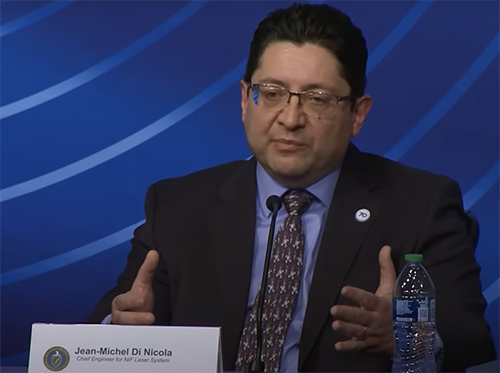 Jean-Michel Di Nicola
Jean-Michel Di Nicola In addition, said Jean-Michel Di Nicola, chief engineer for NIF laser systems, boosting the laser’s power by another 8 percent would provide more margin for ignition. “In the future, with a (facility) sustainment and upgrade investment,” he said, “the NIF laser could produce even higher energies and power and promise larger target gains.”
Laser upgrades and additional optics improvements enabled NIF to reach 2.2 MJ of energy and nearly 450 trillion watts of peak power in October, facilitating additional ignition experiments with fusion yields even higher than the Dec. 5 shot. Researchers believe the laser could potentially deliver as much as 2.6 to 3 MJ later this decade.
“Little changes can make a big difference” in the outcome of an experiment—both positive and negative, Herrmann noted. He said NIF’s goal moving forward is to control the “inherent variabilities” in fusion implosions and continue to consistently produce results in the multi-megajoule range.
“Ignition is a first step,” said Budil, “a truly monumental one that sets the stage for a transformational decade in high energy density science and fusion research, and I cannot wait to see where it takes us.”
Along with the LLNL participants, the researchers credited the experiment’s success to collaborators from Los Alamos and Sandia national laboratories, the Nevada National Security Site, General Atomics, Diamond Materials, the Laboratory for Laser Energetics at the University of Rochester, the academic community including the Massachusetts Institute of Technology, the University of California, Berkeley, and Princeton University, and international partners including the United Kingdom’s Atomic Weapons Establishment and the French Alternative Energies and Atomic Energy Commission.
Next Up: “Designing for Ignition: Precise Changes Yield Historic Results”
More Information:
“The Age of Ignition: A NIF & Photon Science News Special Report”
“Threshold of Ignition: A NIF & Photon Science News Special Report”
“Ignition Gives U.S ‘Unique Opportunity’ to Lead World’s IFE Research,” NIF & Photon Science News, February 2, 2023
“LLNL Scientists Cheer Dawn of the ‘Era of Ignition,’” NIF & Photon Science News, January 4, 2023
Video: “The Beamline to Ignition,” NIF & Photon Science News, November 8, 2022
“High-Laser-Energy Shot Puts NIF Back on Track Toward Ignition,” NIF & Photon Science News, November 7, 2022
“White House summit celebrates fusion milestones, discusses ‘bold’ 10-year plan for commercialization,” LLNL News Release, March 28, 2022
“Beaming With Excellence,” Science & Technology Review, March, 2022
“Nature: How Researchers Achieved Burning Plasma Regime at NIF,” NIF & Photon Science News, February 8, 2022
“Self-heating plasmas offer hope for energy from fusion,” Nature, January 26, 2022
“Fusion Supports the Stockpile,” NIF & Photon Science News, July 29, 2021
“Nuclear Diagnostics Help Pave the Way to Ignition on NIF,” NIF & Photon Science News, March 6, 2020
“National Ignition Facility Celebrates 10 Years of Operation,” Science & Technology Review, June, 2019
“On the Threshold of a Critical Milestone,” Science & Technology Review, April, 2019
—Charlie Osolin
Follow us on Twitter: @lasers_llnl



